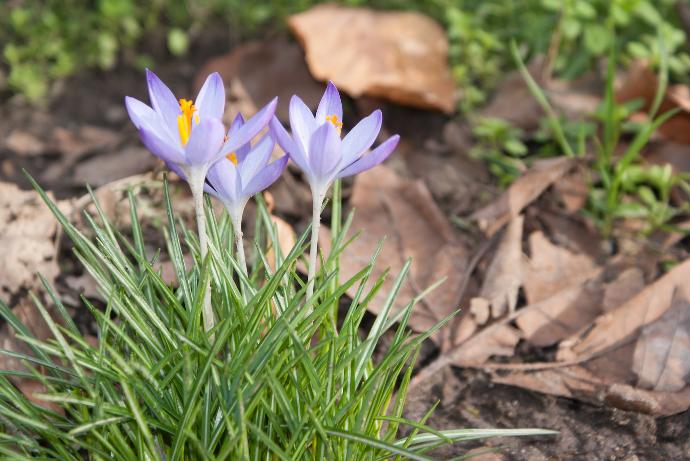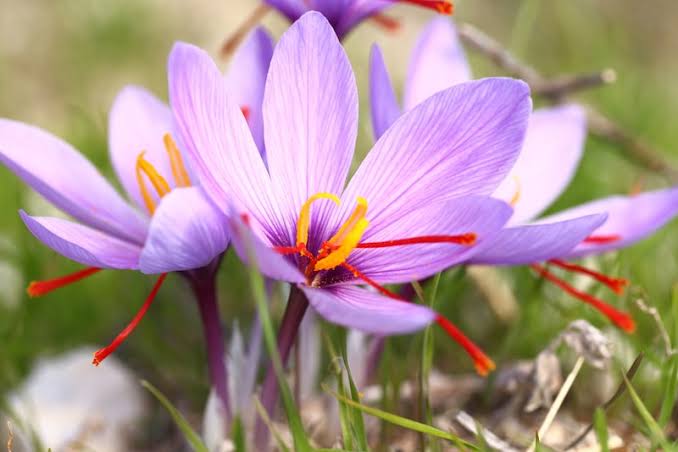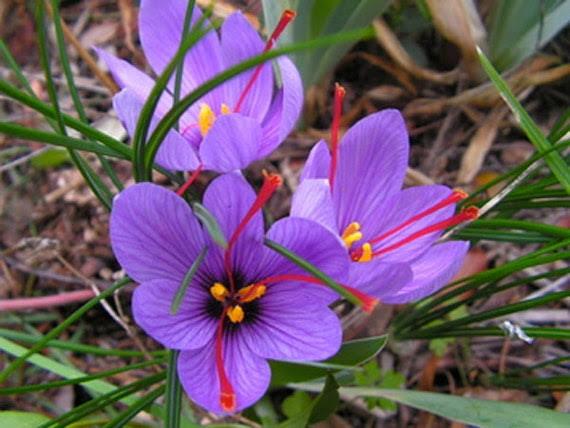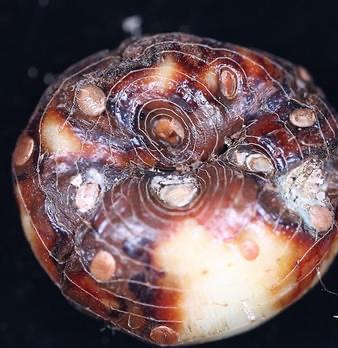Saffron Plant
Saffron, an herb with moderate growth, thrives in well-drained soil and full sun. Hardy in zones 6-9, saffron is known for its valuable red stigmas used in culinary dishes and medicinal preparations.

Habit
Herb
Height
20-30 cm
Growth
Moderate
Soil
Well-drained, sandy, loam
Shade
Full Sun
Moisture
Moderate
Edible
Yes
Medicinal
Yes
Origin
Greece, Iran
Climatic Condition
Temperate, Mediterranean
Temperature (°)
5-20°C
Humidity (%)
40-70%
Potting media
Field soil
Fertilizers
Potassium-rich fertilizers
Watering
Moderate
Plant Weight
2-5 g
Flowering Time
Autumn
Soil Ph level
6.0 - 7.5
Water Ph level
6.0 - 7.5
Soil EC
1-2 dS/m
Yield Per Plant
5-10 g per bulb
NPK ratio
05:10:10
life Span
Perennial
Health Benefits
Antioxidant, boosts mood, medicinal uses
Suggested Grow Media or Potting Mix ?
50% loam, 25% compost, 25% sand
Suggested Fertigation/Fertilizers
Fertilize every 4 weeks with a balanced fertilizer.
Common Diseases and Remedies
corm rot
roots decay and may be covered with mould
jeevamrutham , neem oil
HEALTH BENEFITS
1. Contains crocin and safranal, which have antidepressant and anti-inflammatory properties.
2. Improves memory, mood, and digestion.
What Is An Saffron plant?
Crocus sativus, commonly known as saffron or autumn crocus, is a flowering plant in the genus Iris of the family Iridaceae. It is a bulbous, autumn-blooming, cultivated perennial plant unknown in the wild and best known for its stigmas as a culinary use of the spice saffron.

What Are The Different Types Of Saffron Plants?
Saffron is obtained from the crocus plant, which has no different species. However, there are many different cultivars or cultivars of crocus that may have slightly different characteristics such as flower color, size, or scent. These changes are often the result of selective breeding or environmental factors. Some common types of crocus are:
1. Kashmir Saffron
Known for its deep red crests and rich aroma, Kashmir saffron is prized for its quality and taste. It grows only in the Kashmir region of India.
2. Spanish Saffron
Spanish saffron is another popular variety known for its red color and tangy taste. It is grown in regions of Spain such as La Mancha and is widely used in Spanish cuisine.
3. Iranian Saffron
Iran is one of the world's largest saffron producers and Iranian saffron is famous for its flavor and aroma. It is valued for its deep red color and is used in many types of dishes.
4. Greek Saffron
Greek saffron is grown in the Kozani region of Greece and is known for its fine tops and rich aroma. It is often used in traditional Greek dishes such as risotto and desserts.

1. Location
Saffron is grown in Persia, but is also grown in Spain, France, Italy (lower Apennines) and parts of India. It is a labor-intensive product in which the three stigmas of each flower are collected by hand, spread on trays, and dried over fire for use as food flavoring and coloring.
2. Sun light
Saffron plants require more than 5 hours of direct sunlight equivalent to [15+ mol/m²/day DLI] to grow well. It needs to be very bright to provide the same light to the grow! 24W Sansi seed should be placed 6 inches above the plant.
3. Soil
Saffron grows well at an altitude of 2,000 meters. It requires a 12-hour photoperiod (sunlight). Soil: It can grow in different soil types, but grows best in calcareous (soil rich in calcium carbonate), humus-rich and well-drained soil with a pH between 6 and 8.
4. Hydration
Average total water volume: The amount of water used during irrigation depends on the type of soil, the growth stage of the plant and weather conditions. In general, saffron needs to receive 400-500 mm of water during the growing season.

5. Nourishment
It is important to provide the necessary nutrients to stimulate the growth of your saffron plant (Crocus sativus) and promote healthy leaves and flowers. Here is a summary of the essential nutrients that saffron plants need to grow:
1. * Phosphorus (P): * Phosphorus is essential for root growth, flower production and all major plant growth. Before planting saffron bulbs, add phosphorus-rich compost or bone meal to the soil to encourage root growth and flowering.
2. *Potassium (K):*Potassium plays an important role in plant metabolism, water management and disease resistance. Apply potassium-rich or potassium sulfate to the soil to promote healthy growth and increase the plant's ability to withstand environmental stress.
3. *Nitrogen (N):* Nitrogen is essential for supporting leaf growth and all major plant growth. However, excess nitrogen may result in lush green leaves but may affect flower production. Use a balanced fertilizer low in nitrogen to prevent overgrowth.
4. Soil testing can help identify micronutrient deficiencies, and foliar sprays or soil amendments can be used to correct deficiencies.
5. *Organic Matter:* Adding organic matter such as compost, well-rotted manure, or leaf mold to soil can improve soil fertility, structure, and water retention. Organic matter helps support the overall health of your plants by providing essential nutrients and encouraging the growth of beneficial soil bacteria.
6. *pH:* Saffron plants prefer slightly acidic to neutral soil with a pH between 6.0 and 7.0. Soil pH affects nutrient availability, so proper pH management is important for optimum nutrient availability and plant growth.
7. * Water: * Adequate irrigation is essential for the growth of saffron plants, especially during the growing season and flowering period. Make sure the soil is moist but not waterlogged at all times to encourage healthy root development and flower production.
6. Issues
In saffron (corn rot, root rot, dry rot, bacterial rot, coal rot, ring rot), etc. is available. Corn rot is the most dangerous here.
7. What are the benefits of saffron plant
Saffron is a bright spice rich in health-promoting antioxidants such as carotenoids. Research shows that saffron has anti-inflammatory and antioxidant properties and may improve heart health, reduce symptoms of depression and anxiety, improve sleep, and prevent eye congestion.

FAQs About Growing Saffron Plant
1. How long does it take to grow saffron?
Crocus (Crocus sativus) produces stone-toned flowers rapidly in the fall garden, approximately 6-10 weeks after planting (sometimes as little as 4-6 weeks). 6-10 of the garden. They can be grown in containers on the patio or indoors in their region.
2. How long can saffron bulbs be stored?
The bulbs remain dormant in summer until they bloom after autumn. You can plant saffron all summer long in USDA zones 6 through 9. Then, every 3-4 years, in early autumn, dig, divide and replant the bulbs to encourage more blooms.
3. Can saffron grow without soil?
Hydroponics has revolutionized saffron cultivation by eliminating the need for soil, allowing growers to effectively grow the saffron crop in a closed environment.
4. What is the shelf life of saffron?
Saffron can last for several years if stored properly. To preserve its taste and aroma, store saffron in an airtight container in a cool, dark place, away from moisture and direct sunlight. Saffron threads or saffron powder can stay fresh and maintain its quality for up to 2-4 years if stored properly.
5. Can I grow my own saffron?
While it takes approximately 75,000 flowers to grow one pound of saffron, you can easily grow a large quantity of saffron from a handful for your own enjoyment, and I hope you do! Crocus blooms in autumn with luscious, long ocher-orange stigmas (saffron!) flanked by yellow, pollen-rich anthers

